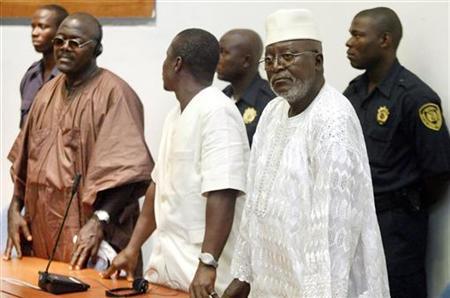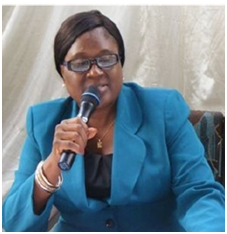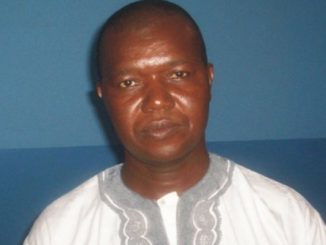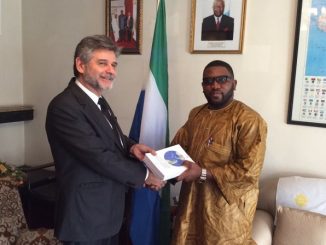
THE SPECIAL COURT FOR SIERRA LEONE
CASE NO. SCSL – 03 – 14 – I
THE PROSECUTOR
Against
SAMUEL HINGA NORMAN
MOININA FOFANA
ALLIEU KONDEWA
INDICTMENT
The Prosecutor, Special Court for Sierra Leone, under Article 15 of the Statute of the Special Court for Sierra Leone (the Statute), charges:
SAM HINGA NORMAN
MOININA FOFANA
ALLIEU KONDEWA
with CRIMES AGAINST HUMANITY, VIOLATIONS OF ARTICLE 3 COMMON TO THE GENEVA CONVENTIONS AND OF ADDITIONAL PROTOCOL II, and OTHER SERIOUS VIOLATIONS OF INTERNATIONAL HUMANITARIAN LAW in violation of Articles 2, 3 and 4 of the Statute, as set forth below:
THE ACCUSED
1. SAMUEL HINGA NORMAN, was born on 1 January 1940, in Ngolala Village, Mongeri (or Monghere), Valunia Chiefdom, Bo District, in the Southern Province of the Republic of Sierra Leone. He served in the Armed Forces of the Republic of Sierra Leone from about 1959 to 1972 rising to the rank of Captain. In 1966 he graduated from the Mons Officer Cadet School in Aldershot, United Kingdom. He has served as the Liaison Representative and Chiefdom Spokesman, Mongeri, Valunia Chiefdom, as Regent Chief of Jaiama Bongor Chiefdom, and as Deputy Minister of Defence for Sierra Leone. He is currently serving as the Minister of the Interior for Sierra Leone.
2. MOININA FOFANA, is believed to have been born in 1950, in Nongoba Bullom Chiefdom, Bonthe District, in the Republic of Sierra Leone. He currently resides in the town of Gbap, Nongoba Bullom Chiefdom, Bonthe District and is the Chiefdom Speaker for the Nongoba Bullom Chiefdom.
3. ALLIEU KONDEWA, also known as (aka) King Dr Allieu Kondewa, (aka) Dr Allieu Kondewa, is believed to have been born in the Bo District, in the Republic of Sierra Leone. He currently resides in the Bumpeh Chiefdom, Bo District, and his occupation is that of a farmer and herbalist.
GENERAL ALLEGATIONS
4. At all times relevant to this Indictment, a state of armed conflict existed in Sierra Leone. For the purposes of this Indictment the organized armed factions involved in this conflict included the Civil Defence Forces (CDF) fighting against the combined forces of the Revolutionary United Front (RUF) and the Armed Forces Revolutionary Council (AFRC).
5. A nexus existed between the armed conflict and all acts or omissions charged herein as Violations of Article 3 common to the Geneva Conventions and of Additional Protocol II and as Other Serious Violations of International Humanitarian Law.
6. The CDF was an organized armed force comprising various tribally-based traditional hunters. The Kamajors were comprised mainly of persons from the Mende tribe resident in the South and East of Sierra Leone, and were the predominant group within the CDF. Other groups playing a less dominant role were the Gbethis and the Kapras, both comprising mainly of Temnes from the north; the Tamaboros, comprising mainly of Korankos also from the north; and the Donsos, comprising mainly of Konos from the east.
7. The RUF was founded about 1988 or 1989 in Libya and began organized armed operations in Sierra Leone in or about March 1991. The AFRC was founded by members of the Armed Forces of Sierra Leone who seized power from the elected government of Sierra Leone via a coup d’�tat on 25 May 1997. Soldiers of the Sierra Leone Army comprised the majority of the AFRC membership. Shortly after the AFRC seized power, the RUF joined with the AFRC.
8. The ACCUSED and all members of the CDF were required to abide by International Humanitarian Law and the laws and customs governing the conduct of armed conflicts, including the Geneva Conventions of 12 August 1949, and Additional Protocol II to the Geneva Conventions, to which the Republic of Sierra Leone acceded on 21 October 1986.
9. All offences charged herein were committed within the territory of Sierra Leone after 30 November 1996.
10. All acts or omissions charged herein as Crimes Against Humanity were committed as part of a widespread or systematic attack directed against the civilian population of Sierra Leone.
11. The words civilian or civilian population used in this indictment refer to persons who took no active part in the hostilities, or were no longer taking an active part in the hostilities.
INDIVIDUAL CRIMINAL RESPONSIBILITY
12. Paragraphs 4 through 11 are incorporated by reference.
13. At all times relevant to this Indictment, SAMUEL HINGA NORMAN was the National Coordinator of the CDF. As such he was the principal force in establishing, organizing, supporting, providing logistical support, and promoting the CDF. He was also the leader and Commander of the Kamajors and as such had de jure and de facto command and control over the activities and operations of the Kamajors.
14. At all times relevant to this Indictment, MOININA FOFANA was the National Director of War of the CDF and ALLIEU KONDEWAwas the High Priest of the CDF. As such, together with SAMUEL HINGA NORMAN, MOININA FOFANA and ALLIEU KONDEWAwere seen and known as the top leaders of the CDF. MOININA FOFANA and ALLIEU KONDEWA took directions from and were directly answerable to SAMUEL HINGA NORMAN. They took part in policy, planning and operational decisions of the CDF.
15. MOININA FOFANA acted as leader of the CDF in the absence of SAMUEL HINGA NORMAN and was regarded as the second in command. As National Director of War, he had direct responsibility for implementing policy and strategy for prosecuting the war. He liaised with field commanders, supervised and monitored operations. He gave orders to and received reports about operations from subordinate commanders, and he provided them with logistics including supply of arms and ammunition. In addition to the duties listed above at the national CDF level, MOININA FOFANA commanded one battalion of Kamajors.
16. ALLIEU KONDEWA, as High Priest had supervision and control over all initiators within the CDF and was responsible for all initiations within the CDF, including the initiation of children under the age of 15 years. Furthermore, he frequently led or directed operations and had direct command authority over units within the CDF responsible for carrying out special missions.
17. SAMUEL HINGA NORMAN, as National Coordinator of the CDF and Commander of the Kamajors knew and approved the recruiting, enlisting, conscription, initiation, and training of Kamajors, including children below the age of 15 years. SAMUEL HINGA NORMAN; MOININA FOFANA, as the National Director of War of the CDF; and ALLIEU KONDEWA, as the High Priest of the CDF, knew and approved the use of children to participate actively in hostilities.
18. In the positions referred to in the aforementioned paragraphs, SAMUEL HINGA NORMAN, MOININA FOFANA and ALLIEU KONDEWA, individually or in concert, exercised authority, command and control over all subordinate members of the CDF.
19. The plan, purpose or design of SAMUEL HINGA NORMAN, MOININA FOFANA, ALLIEU KONDEWA and subordinate members of the CDF was to use any means necessary to defeat the RUF/AFRC forces and to gain and exercise control over the territory of Sierra Leone. This included gaining complete control over the population of Sierra Leone and the complete elimination of the RUF/AFRC, its supporters, sympathizers, and anyone who did not actively resist the RUF/AFRC occupation of Sierra Leone. EachAccused acted individually and in concert with subordinates, to carry out the said plan, purpose or design.
20. SAMUEL HINGA NORMAN, MOININA FOFANA and ALLIEU KONDEWA, by their acts or omissions are individually criminally responsible pursuant to Article 6.1. of the Statute for the crimes referred to in Articles 2, 3 and 4 of the Statute as alleged in this indictment, which crimes each of them planned, instigated, ordered, committed, or in whose planning, preparation or execution eachAccused otherwise aided and abetted, or which crimes were within a common purpose, plan or design in which each Accusedparticipated or were a reasonably foreseeable consequence of the common purpose, plan or design in which each Accusedparticipated.
21. In addition, or alternatively, pursuant to Article 6.3. of the Statute, SAMUEL HINGA NORMAN, MOININA FOFANA and ALLIEU KONDEWA, while holding positions of superior responsibility and exercising command and control over their subordinates, are individually criminally responsible for the crimes referred to in Articles 2, 3, and 4 of the Statute. Each Accused is responsible for the criminal acts of his subordinates in that he knew or had reason to know that the subordinate was about to commit such acts or had done so and each Accused failed to take the necessary and reasonable measures to prevent such acts or to punish the perpetrators thereof.
CHARGES
22. Paragraphs 4 through 21 are incorporated by reference.
23. The CDF, largely Kamajors, engaged the combined RUF/AFRC forces in armed conflict in various parts of Sierra Leone – to include the towns of Tongo Field, Kenema, Bo, Koribondo and surrounding areas and the Districts of Moyamba and Bonthe. Civilians, including women and children, who were suspected to have supported, sympathized with, or simply failed to actively resist the combined RUF/AFRC forces were termed “Collaborators” and specifically targeted by the CDF. Once so identified, these “Collaborators” and any captured enemy combatants were unlawfully killed. Victims were often shot, hacked to death, or burnt to death. Other practices included human sacrifices and cannibalism.
24. These actions by the CDF, largely Kamajors, which also included looting, destruction of private property, personal injury and the extorting of money from civilians, were intended to threaten and terrorize the civilian population. Many civilians saw these crimes committed; others returned to find the results of these crimes – dead bodies, mutilated victims and looted and burnt property. Typical CDF actions and the resulting crimes included:
a. Between 1 November 1997 and about 1 April 1998, multiple attacks on Tongo Field and surrounding areas and towns during which Kamajors unlawfully killed or inflicted serious bodily harm and serious physical suffering on an unknown number of civilians and captured enemy combatants. Kamajors screened the civilians and those identified as “Collaborators,” along with any captured enemy combatants, were unlawfully killed.
b. On or about 15 February 1998 Kamajors attacked and took control of the town of Kenema. In conjunction with the attack and following the attack, both at and near Kenema and at a nearby location known as SS Camp, Kamajors continued to identify suspected “Collaborators,” unlawfully killing or inflicting serious bodily harm and serious physical suffering on an unknown number of civilians and captured enemy combatants. Kamajors also entered the police barracks in Kenema and unlawfully killed an unknown number of Sierra Leone Police Officers.
c. In or about January and February 1998, the Kamajors attacked and took control of the towns of Bo, Koribondo, and the surrounding areas. Thereafter, the practice of killing captured enemy combatants and suspected “Collaborators” continued and as a result, Kamajors unlawfully killed or inflicted serious bodily harm and serious physical suffering on an unknown number of civilians and enemy combatants. Also, as part of these attacks in and around Bo and Koribondo, Kamajors unlawfully destroyed and looted an unknown number of civilian owned and occupied houses, buildings and businesses.
d. Between about October 1997 and December 1999, Kamajors attacked or conducted armed operations in the Moyamba District, to include the towns of Sembehun and Gbangbatoke. As a result of the actions Kamajors continued to identify suspected “Collaborators” and others suspected to be not supportive of the Kamajors and their activities. Kamajors unlawfully killed an unknown number of civilians. They unlawfully destroyed and looted civilian owned property.
e. Between about October 1997 and December 1999, Kamajors attacked or conducted armed operations in the Bonthe District, generally in and around the towns and settlements of Talia, Tihun, Maboya, Bolloh, Bembay, and the island town of Bonthe. As a result of these actions Kamajors identified suspected “Collaborators” and others suspected to be not supportive of the Kamajors and their activities. They unlawfully killed an unknown number of civilians. They destroyed and looted civilian owned property.
f. In an operation called “Black December,” the CDF blocked all major highways and roads leading to and from major towns mainly in the southern and eastern Provinces. As a result of these actions, the CDF unlawfully killed an unknown number of civilians and captured enemy combatants.
COUNTS 1 – 2: UNLAWFUL KILLINGS
25. Unlawful killings included the following:
a. between about 1 November 1997 and about 30 April 1998, at or near Tongo Field, and at or near the towns of Lalehun, Kamboma, Konia, Talama, Panguma and Sembehun, Kamajors unlawfully killed an unknown number of civilians and captured enemy combatants;
b. on or about 15 February 1998, at or near the District Headquarters town of Kenema and at the nearby locations of SS Camp, and Blama, Kamajors unlawfully killed an unknown number of civilians and captured enemy combatants;
c. on or about 15 February 1998, at or near Kenema, Kamajors unlawfully killed an unknown number of Sierra Leone Police Officers;
d. in or about January and February 1998, in locations in Bo District including the District Headquarters town of Bo, Kebi Town, Koribondo, Kpeyama, Fengehun and Mongere, Kamajors unlawfully killed an unknown number of civilians and captured enemy combatants;
e. between about October 1997 and December 1999 in locations in Moyamba District, including Sembehun, Taiama, Bylago, Ribbi and Gbangbatoke, Kamajors unlawfully killed an unknown number of civilians;
f. between about October 1997 and December 1999 in locations in Bonthe District including Talia (Base Zero), Mobayeh, Makose and Bonthe Town, Kamajors unlawfully killed an unknown number of civilians;
g. between about 1 November 1997 and about 1 February 1998, as part of Operation Black December in the southern and eastern Provinces of Sierra Leone, the CDF unlawfully killed an unknown number of civilians and captured enemy combatants in road ambushes at Gumahun, Gerihun, Jembeh and the Bo-Matotoka Highway.
By their acts or omissions in relation to these events, SAMUEL HINGA NORMAN, MOININA FOFANA and ALLIEU KONDEWA, pursuant to Article 6.1. and, or alternatively, Article 6.3. of the Statute, are individually criminally responsible for the crimes alleged below:
Count 1: Murder, a CRIME AGAINST HUMANITY, punishable under Article 2.a. of the Statute of the Court;
In addition, or in the alternative:
Count 2: Violence to life, health and physical or mental well-being of persons, in particular murder, a VIOLATION OF ARTICLE 3 COMMON TO THE GENEVA CONVENTIONS AND OF ADDITIONAL PROTOCOL II, punishable under Article 3.a. of the Statute.
COUNTS 3 – 4: PHYSICAL VIOLENCE AND MENTAL SUFFERING
26. Acts of physical violence and infliction of mental harm or suffering included the following:
a. between about 1 November 1997 and 30 April 1998, at various locations, including Tongo Field, Kenema Town, Blama, Kamboma and the surrounding areas, the CDF, largely Kamajors, intentionally inflicted serious bodily harm and serious physical suffering on an unknown number of civilians;
b. between November 1997 and December 1999, in the towns of Tongo Field, Kenema, Bo, Koribondo and surrounding areas, and the Districts of Moyamba and Bonthe, the intentional infliction of serious mental harm and serious mental suffering on an unknown number of civilians by the actions of the CDF, largely Kamajors, including screening for “Collaborators,” unlawfully killing of suspected “Collaborators,” often in plain view of friends and relatives, illegal arrest and unlawful imprisonment of “Collaborators“, the destruction of homes and other buildings, looting and threats to unlawfully kill, destroy or loot.
By their acts or omissions in relation to these events, SAMUEL HINGA NORMAN, MOININA FOFANA and ALLIEU KONDEWA, pursuant to Article 6.1. and, or alternatively, Article 6.3.of the Statute, are individually criminally responsible for the crimes alleged below:
Count 3: Inhumane Acts, a CRIME AGAINST HUMANITY, punishable under Article 2.i. of the Statute;
In addition, or in the alternative:
Count 4: Violence to life, health and physical or mental well-being of persons, in particular cruel treatment, a VIOLATION OF ARTICLE 3 COMMON TO THE GENEVA CONVENTIONS AND OF ADDITIONAL PROTOCOL II, punishable under Article 3.a. of Statute.
COUNT 5: LOOTING AND BURNING
27. Looting and burning included, between about 1 November 1997 and about 1 April 1998, at various locations including in Kenema District, the towns of Kenema, Tongo Field and surrounding areas, in Bo District, the towns of Bo, Koribondo, and the surrounding areas, in Moyamba district, the towns of Sembehun, Gbangbatoke and surrounding areas, and in Bonthe District, the towns of Talia (Base Zero), Bonthe Town, Mobayeh, and surrounding areas, the unlawful taking and destruction by burning of civilian owned property.
By their acts or omissions in relation to these events, SAMUEL HINGA NORMAN, MOININA FOFANA and ALLIEU KONDEWA, pursuant to Article 6.1. and, or alternatively, Article 6.3.of the Statute, are individually criminally responsible for the crime alleged below:
Count 5: Pillage, a VIOLATION OF ARTICLE 3 COMMON TO THE GENEVA CONVENTIONS AND OF ADDITIONAL PROTOCOL II, punishable under Article 3.f. of the Statute.
COUNTS 6 – 7: TERRORIZING THE CIVILIAN POPULATION and COLLECTIVE PUNISHMENTS
28. At all times relevant to this Indictment, the CDF, largely Kamajors, committed the crimes set forth in paragraphs 22 through 27 and charged in counts 1 through 5, including threats to kill, destroy and loot, as part of a campaign to terrorize the civilian populations of those areas and did terrorize those populations. The CDF, largely Kamajors, also committed the crimes to punish the civilian population for their support to, or failure to actively resist, the combined RUF/AFRC forces.
By their acts or omissions in relation to these events, SAMUEL HINGA NORMAN, MOININA FOFANA and ALLIEU KONDEWA, pursuant to Article 6.1. and, or alternatively, Article 6.3. of the Statute, are individually criminally responsible for the crimes alleged below:
Count 6: Acts of Terrorism, a VIOLATION OF ARTICLE 3 COMMON TO THE GENEVA CONVENTIONS AND OF ADDITIONAL PROTOCOL II, punishable under Article 3.d. of the Statute;
And:
Count 7: Collective Punishments, a VIOLATION OF ARTICLE 3 COMMON TO THE GENEVA CONVENTIONS AND OF ADDITIONAL PROTOCOL II, punishable under Article 3.b. of the Statute.
COUNT 8: USE OF CHILD SOLDIERS
29. At all times relevant to this Indictment, the Civil Defence Forces did, throughout the Republic of Sierra Leone, initiate or enlist children under the age of 15 years into armed forces or groups, and in addition, or in the alternative, use them to participate actively in hostilities.
By their acts or omissions in relation to these events, SAMUEL HINGA NORMAN, MOININA FOFANA and ALLIEU KONDEWA, pursuant to Article 6.1. and, or alternatively, Article 6.3. of the Statute, are individually criminally responsible for the crime alleged below:
Count 8: Enlisting children under the age of 15 years into armed forces or groups or using them to participate actively in hostilities, anOTHER SERIOUS VIOLATION OF INTERNATIONAL HUMANITARIAN LAW, punishable under Article 4.c. of the Statute.
Dated this 4th day of February 2004
Freetown, Sierra Leone
______________________________
David M. Crane
The Prosecutor




Leave a Reply